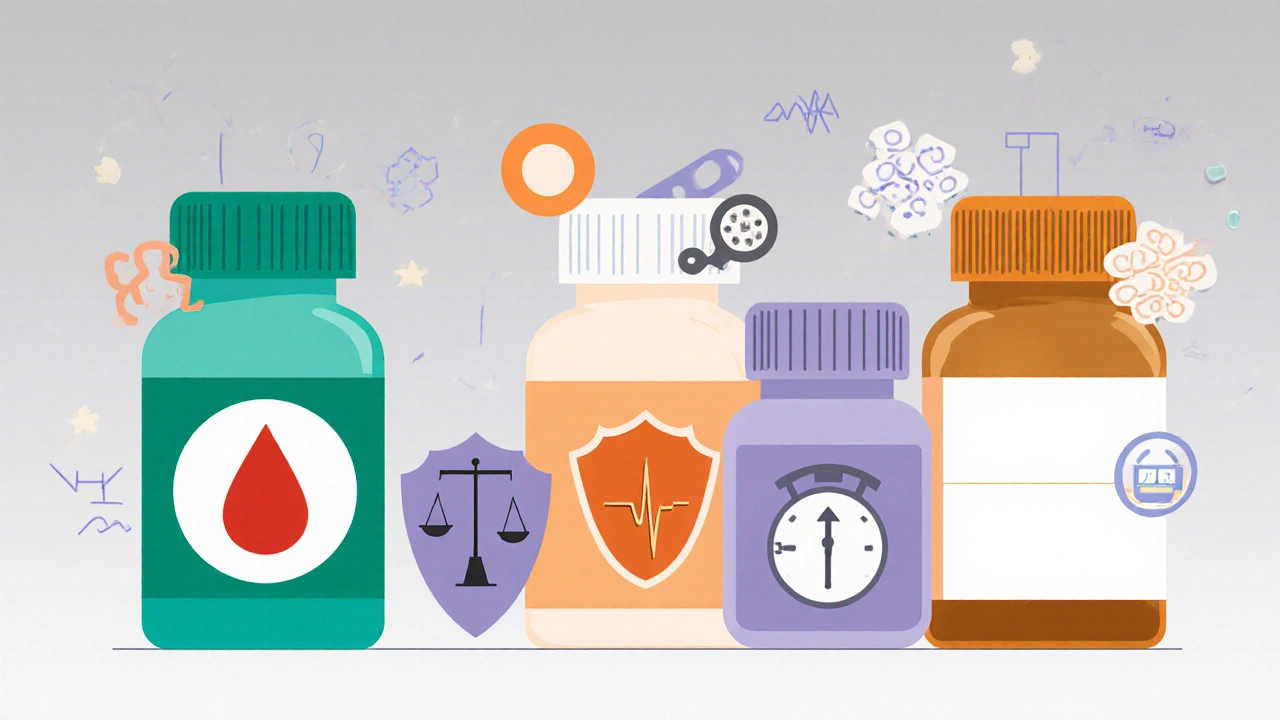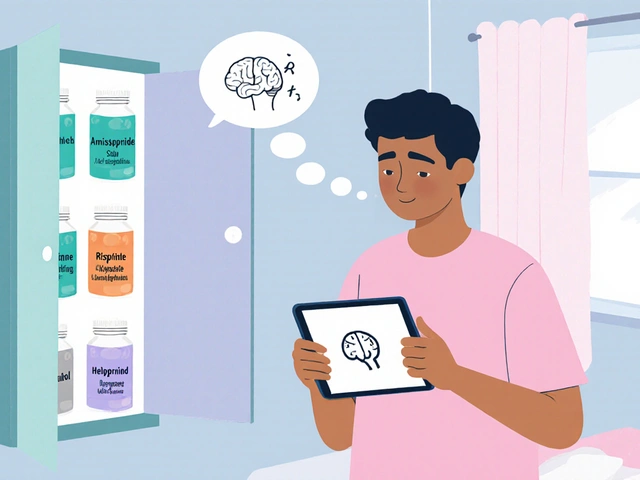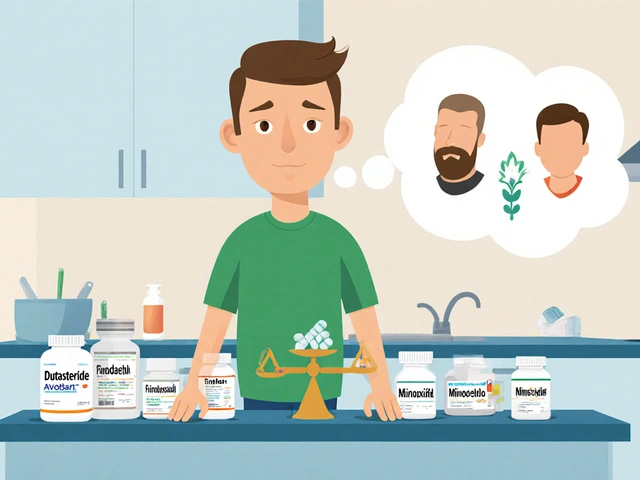Clozapine vs. Alternative Antipsychotics: Treatment Decision Tool
Recommended Treatment Plan
Based on your inputs, here is a suggested approach:
When a patient’s schizophrenia stops responding to first‑line drugs, doctors often turn to Clozapine is an atypical antipsychotic approved for treatment‑resistant schizophrenia (TRS) and known for its unique efficacy profile. While it can be a game‑changer, the drug carries strict monitoring rules and a side‑effect spectrum that many find daunting. That’s why clinicians and patients alike ask: what are the realistic alternatives, and how do they stack up?
Why Compare Clozapine with Other Antipsychotics?
Three main jobs drive this comparison:
- Identify which drugs can replace Clozapine when blood monitoring is not feasible.
- Weigh efficacy against safety for people with TRS.
- Help insurers, prescribers, and families understand cost and accessibility trade‑offs.
Answering these questions means looking at mechanism of action, response rates, side‑effect profiles, dosing requirements, and real‑world availability.
Key Comparison Criteria
To keep the analysis focused, we rate each medication on six attributes:
- Mechanism - how the drug blocks dopamine or other receptors.
- Efficacy in TRS - percentage of patients achieving meaningful symptom reduction.
- Common side effects - metabolic, cardiac, neurological, and hematologic risks.
- Monitoring burden - lab tests or clinical checks required.
- Typical dose range - milligrams per day for adult patients.
- Cost (AU$) - average monthly price on the Australian PBS.
Side‑by‑Side Comparison Table
| Drug | Mechanism | TRS Efficacy* | Key Side Effects | Monitoring | Typical Dose (mg/day) | Monthly Cost (AU$) |
|---|---|---|---|---|---|---|
| Clozapine | D2 & 5‑HT2A antagonist with high affinity for D4 | ~60% respond | Agranulocytosis, sedation, weight gain, myocarditis | Weekly CBC for first 6weeks, then bi‑weekly | 200-900 | ≈$150 |
| Olanzapine | D2 & 5‑HT2A antagonist, strong antihistamine | ~30% respond | Weight gain, hyperglycemia, drowsiness | Baseline metabolic panel, then quarterly | 5-20 | ≈$80 |
| Risperidone | D2 & 5‑HT2A antagonist, serotonin‑dopamine balance | ~25% respond | Prolactin elevation, EPS, mild weight gain | Baseline prolactin, optional ECG | 1-8 | ≈$45 |
| Quetiapine | D2 partial agonist, strong H1 antihistamine | ~20% respond | Sedation, orthostatic hypotension, modest weight gain | Baseline metabolic panel, then every 6months | 150-800 | ≈$70 |
| Haloperidol | Typical antipsychotic, strong D2 blockade | ~15% respond | Extrapyramidal symptoms, tardive dyskinesia, QT prolongation | Baseline ECG, periodic EPS assessment | 2-20 | ≈$30 |
*Efficacy percentages are drawn from meta‑analyses published in the American Journal of Psychiatry (2023) and the Australian Schizophrenia Research Consortium (2024).
Deep Dive into Each Alternative
Olanzapine
Olanzapine, marketed under the name Zyprexa, is an atypical antipsychotic that shares Clozapine’s broad receptor activity but lacks the severe hematologic risk. Its biggest draw is rapid symptom control in acute episodes, but the trade‑off is pronounced weight gain-average BMI increase of 4kg/m² over six months (Schizophrenia Study Group, 2023). For patients who can’t handle weekly blood draws, Olanzapine becomes the go‑to option, especially when metabolic monitoring is already part of routine care.
Risperidone
Risperidone (Risperdal) offers a tighter dopamine‑serotonin balance, which translates into lower sedation than Olanzapine. However, prolactin elevation is common-up to 35% of users report galactorrhea or menstrual irregularities (Endocrine Review, 2022). Its efficacy in TRS is modest, making it suitable for patients with milder residual symptoms rather than full‑blown resistance.
Quetiapine
Quetiapine (Seroquel) is often labeled “the sleepy pill” because of its strong antihistamine effect. While it can calm agitation, the dose needed for antipsychotic effect (300-800mg) also brings significant sedation. Some clinicians use low‑dose quetiapine to manage insomnia in schizophrenia, but as a primary TRS agent its response rate stays below 25%.
Haloperidol
Haloperidol is a first‑generation (typical) antipsychotic that still finds a niche in acute agitation due to its rapid onset. Its side‑effect profile leans heavily on movement disorders-up to 40% develop akathisia or dystonia without prophylactic anticholinergics. Because it does not cause agranulocytosis, it’s sometimes employed when blood monitoring infrastructure is unavailable, but clinicians must vigilantly watch ECGs for QT prolongation.
When to Stay on Clozapine
Even with its monitoring demands, Clozapine remains the only drug that consistently shows ≥50% response in TRS. If a patient has already failed two other atypicals, the risk‑benefit calculation often tips toward staying the course. Key scenarios that favor Clozapine include:
- Documented failure of ≥2 non‑clozapine antipsychotics.
- Presence of persistent positive symptoms (hallucinations, delusions) despite adequate dosing.
- Ability to adhere to weekly absolute neutrophil count (ANC) testing.
- No prior history of severe agranulocytosis or neutropenia.
When these conditions are met, the benefits of symptom control often outweigh the logistical hurdles.

Practical Decision Guide
Below is a quick decision flow you can run through with a patient or colleague:
- Has the patient tried at least two other atypicals at therapeutic doses for ≥6weeks? If no, keep testing alternatives before moving to Clozapine.
- Is weekly CBC feasible (clinic access, transport, insurance coverage)? If no, consider Olanzapine or Haloperidol.
- Does the patient have a high metabolic risk (diabetes, obesity)? If yes, weigh Risperidone (lower weight gain) against Clozapine’s superior efficacy.
- Is sedation a major concern (e.g., needing to work or study)? Opt for Risperidone or low‑dose Quetiapine.
- Any history of cardiac arrhythmias? Avoid Haloperidol; prefer Olanzapine with ECG monitoring.
This framework keeps the conversation patient‑centered and evidence‑driven.
Cost and Accessibility in Australia
The Pharmaceutical Benefits Scheme (PBS) subsidizes all five drugs, but out‑of‑pocket costs differ. Clozapine’s weekly monitoring program adds hidden expenses-travel, lab fees, and occasional hospital admissions for neutropenia. Olanzapine’s monthly cost sits around $80, but the metabolic monitoring schedule adds quarterly fasting glucose and lipid panels, costing an extra $30-$40 per test.
Risperidone and Haloperidol are the cheapest options, making them attractive for patients on low incomes. However, their lower efficacy in TRS may lead to indirect costs such as increased hospital stays.
Safety Tips for Clinicians
Regardless of the drug chosen, a few safety habits reduce adverse events:
- Document baseline weight, BMI, fasting glucose, lipid panel, and ECG before initiating therapy.
- Educate patients on early signs of agranulocytosis (fever, sore throat) and metabolic upset (excessive thirst, unexplained weight gain).
- Schedule follow‑up labs at the intervals shown in the table; don’t stretch them out to save appointments.
- When switching from Clozapine, taper over 2-4weeks to avoid rebound psychosis.
- Consider adding metformin prophylactically if using Olanzapine or Clozapine and the patient has a BMI>30kg/m².
Future Directions
Research into long‑acting injectable (LAI) forms of Clozapine is ongoing. Early phase‑II trials (2024) suggest LAI could eliminate weekly blood draws while maintaining safety, but regulatory approval isn’t expected before 2027. Meanwhile, novel agents like Pimavanserin for psychosis are being evaluated for TRS, but still lack robust data.
Key Takeaways
- Clozapine offers the highest response rate for treatment‑resistant schizophrenia but demands strict blood monitoring.
- Olanzapine is the closest alternative in efficacy, trading hematologic safety for metabolic concerns.
- Risperidone and Quetiapine are useful when sedation or prolactin issues can be managed.
- Haloperidol remains a low‑cost option for acute agitation but carries high movement‑disorder risk.
- Decision‑making should balance symptom control, side‑effect tolerance, monitoring feasibility, and cost.
Frequently Asked Questions
How quickly does Clozapine start working compared to other antipsychotics?
Clozapine often shows noticeable improvement within 2-4weeks, which is comparable to other atypicals. However, its peak efficacy may take 8‑12weeks of stable dosing, longer than many second‑generation agents.
Can I switch from Clozapine to Olanzapine if I develop agranulocytosis?
Yes. A gradual taper of Clozapine over 2‑4weeks reduces rebound psychosis risk, then Olanzapine can be started at a low dose and titrated upward. Throughout the switch, monitor CBC until the agranulocytosis risk is cleared.
Is the metabolic monitoring for Olanzapine as frequent as Clozapine’s CBC?
Olanzapine requires baseline metabolic labs and then quarterly checks, which is less intensive than weekly CBCs for Clozapine. Still, patients with diabetes risk need tighter follow‑up.
What are the signs of Clozapine‑induced myocarditis?
Early myocarditis may present with flu‑like symptoms, chest pain, shortness of breath, or unexplained tachycardia. If these appear, stop Clozapine immediately and order cardiac enzymes and an ECG.
Are there any oral‑only formulations of Clozapine?
Clozapine is available only as oral tablets and a liquid suspension. No depot or transdermal versions exist yet, which is why daily adherence and monitoring are crucial.








Amy Robbins October 4, 2025
Wow, the weekly CBC requirement for clozapine really showcases how our healthcare bureaucracy loves to keep patients chained to labs while pretending it’s for safety; good luck finding a clinic that stays open past 5 pm, especially if you’re not waving a flag.
Shriniwas Kumar October 18, 2025
From a pharmacogenomic standpoint, the metabolic profile of olanzapine aligns with South‑Asian allele frequencies, making its insulin‑resistance risk markedly higher in our population; thus, clinicians should calibrate dosing algorithms using BMI‑adjusted pharmacokinetic models.
Jennifer Haupt October 31, 2025
Ethically, the decision matrix must weigh the principle of beneficence against the paternalistic imposition of invasive monitoring; when patients possess autonomous capacity, the clinician’s duty is to present the comparative risk‑benefit tableau without coercion.
NANDKUMAR Kamble November 14, 2025
The pharmaceutical giants have secretly funded the weekly‑CBC mandate to keep clozapine sales soaring, ensuring that rival drugs never gain a foothold while we, the unsuspecting public, bear the burden.
namrata srivastava November 28, 2025
One must acknowledge the ontological primacy of the dopamine‑serotonin interplay, wherein clozapine’s D4 affinity confers a supra‑clinical efficacy that merely approximates the Platonic form of antipsychotic ideality.